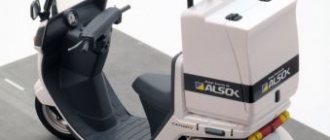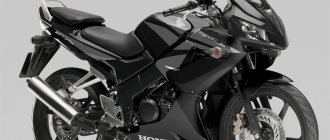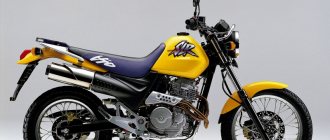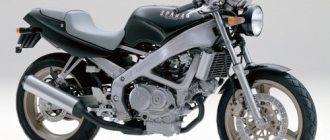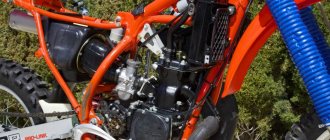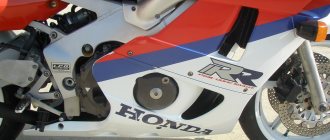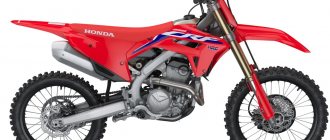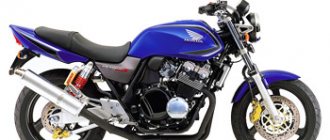The Japanese manufacturer Honda is well known in the motorcycle market to both professional riders and ordinary amateurs. Models of this brand are distinguished by the reliability of their components, powerful engines and original design. Some families of motorcycles have several generations, which confirms the high quality of these products. This series can also include the Honda VTR 250 model, the photo of which is presented below.
General information about the motorcycle
The model represents the classic performance of a road motorcycle. The development entered the market in 1997 and was aimed primarily at the Asian market. However, in 2009, the bike became available to Europeans, which motivated the creators to continue the development of the family. The design and overall construction of the model was initially distinguished by the presence of sporting features, which were interspersed with off-road characteristics. It is enough to note the slightly raised tail section and the dashboard, which looks reminiscent of the Italian Ducati-Monster line. But at the same time, the model also embodies many original qualities, which a review of the Honda VTR 250 and its technical and operational data will help you understand.
Specifications
The device has a traditional design, which ensures its practicality and reliability in operation. Again, the high service life of the parts, coupled with the original frame configuration, also affected the user-friendliness. Now you can take a closer look at the parameters of the Honda VTR 250. The technical characteristics of the motorcycle look like this:
- Dimensions – 204 cm in length, 72 cm in width and 105 cm in height.
- The height of the bike at the saddle is 78 cm.
- Ignition type – transistor.
- The gearbox is five-speed.
- Drive type – chain.
- The front brakes are 29.6 cm discs with a two-piston caliper.
- The rear brakes are disc brakes with a single-piston caliper.
- Front suspension - 4.1 cm with a telescopic fork of the Shova brand.
- The rear suspension of the motorcycle is implemented with a monoshock absorber with a progression of the Pro-Link system.
- Fuel tank capacity – 13 l.
- Weight – 139 kg.
Predecessor[edit]
The VT250F is a semi-circuit design sports motorcycle first produced by Honda in 1982.
The motorcycle had a DOHC twin-cylinder engine with 4 valves per cylinder and 90-degree water cooling, which significantly reduced primary vibration compared to the inline twin engines used on similar machines. The V-twin engine also allowed the bike to have a low center of gravity and a low seat height.
The front brake was a single internal ventilated disc that was designed for improved braking performance and feel. This was only seen on Honda models for a few years, before the move to sintered brake pads with a more traditional disc/caliper arrangement. Other features include a hydraulic clutch, Comstar wheels with tubeless tires, TRAC anti-dive front forks and Pro-Link rear suspension. The engine coolant passed through one of the frame tubes. The early UK model had integrated front fairing indicators, as well as optional radiator side fairings and a pan. Following the VT250F, the VT250 Spada and VTR250 were produced.
Characteristics of the power unit
The bike is equipped with a two-cylinder four-stroke engine, the output of which, with a volume of 249 cm 3, is 30 liters. With. There are conflicting opinions regarding the performance and thrust of the installation. On the one hand, the latest generations of the model demonstrate an order of magnitude higher productivity than previous generations. On the other hand, in the general segment, in terms of these indicators, the unit seriously loses to its competitors. This is largely due to the modest displacement of the 250 VTR engine. Honda notes that despite the low initial data, the power plant is still reliable and trouble-free in operation. And the practice of users, by the way, confirms this. In addition, experienced riders point to another positive aspect of using a low-performance engine - economical gas mileage. So, according to official data, the bike consumes only 2.5 liters per 100 km. Motorcycle owners talk about 3 liters on average, but this value also makes the model profitable in terms of fuel costs.
Successor[edit]
The Honda VTR250 is a 90° V-twin motorcycle produced by Honda that has undergone one major redesign so far. The original VTR250 was a streamlined model sold only in the US and Canada from 1988 to 1990. The current VTR250 model is a naked bike produced from 1997 to the present, available only in the Asia-Pacific region and, since 2009, in Europe.
The Honda Interceptor VTR250 was sold only in the United States from 1988 to 1990, with moderate changes occurring over its three model years. VTR250 with a 249cc, liquid-cooled, four-stroke, V-twin engine. 15.2 cc (15.2 cu in) and six-speed transmission was the smallest of Honda's Interceptor line of motorcycles.
The 1990 model had a 17-inch front wheel and front disc brakes were external.
Control and dynamics
The model feels confident in its natural environment – on the road surface. The device is not suitable for racing and off-road racing. A reliable motor ensures coordinated operation of the internal filling, which allows you to feel comfortable while moving. For this reason, many consider this motorcycle almost ideal for a novice rider. At the same time, the Honda VTR 250 has good dynamics – the maximum speed and acceleration characteristics are 160 km/h and 8 seconds to 100 km/h, respectively. It is worth noting that to increase safety when driving at high speeds, it is recommended to purchase a windshield. According to many owners, this accessory spoils the appearance of the bike, but for the sake of practicality and safety, it is better not to ignore such recommendations.
Modifications
Since the appearance of the motorcycle on the European market, the Japanese have updated the model several times, including increasing power. One of the most striking modifications is the VTR-F 250 version, in which the features of Italian bikes are most pronounced. True, the creators decided to leave the engine the same – with a power of 30 hp. With. Despite the similarity with Ducati models, the new version of the 250 VTR Honda is distinguished by its modest price tag, reliability and ease of maintenance. New technologies can also be seen in this device. In particular, the motorcycle received a liquid crystal display, above which, however, there is the usual stopwatch and tachometer in an analog version. As for structural improvements, the engineers reduced the saddle height to 74 cm. This is especially valuable for short riders. The latest developments in motorcycle technology have also appeared in the form of a catalytic converter with two oxygen sensors. The introduction of these systems was caused by the desire to comply with new environmental requirements.
Positive reviews about the motorcycle
The motorcycle segment was very dynamic even decades ago, but today some of its niches are completely taken over by fundamentally different categories of individual transport. However, there are many dedicated connoisseurs of classic road bikes. This category of users primarily notes the external data of the 250 VTR. Honda has retained the general design style, for which this model is mainly appreciated. Users place reliability and durability in second place on the list of advantages of this bike. Confirmation of the high resource of the element base is more than 10 years of operation of such motorcycles without major interventions in the design. Another thing is that many riders decide on tuning updates in accordance with the latest fashion. And from the point of view of modifications, the Japanese motorcycle also acts as a completely friendly base.
Honda BF250D XDU
This is what a class-leading outboard motor looks like
Featuring a unique blend of automotive and marine technologies, the BF250 showcases Honda's highest level of engineering and technical excellence. If you've been looking for the ultimate water experience, you've found it.
The BF250 is the first outboard to feature self-contained air intake circuits.
The BF250's performance was achieved through the use of a 3.6 V6 engine along with the world's first DIRECT AIR INTAKE system. This system is designed to reduce the temperature of the intake flow, which increases the mass of air consumed and, as a result, leads to an increase in power.
Power is not in a dream, but in reality
The legendary 3.6-liter V6 engine was built to win races. The BF250 features exclusive Honda technologies such as BLAST™, which significantly improves launch performance, and VTEC™, which allows you to get plenty of power at all times. These innovations, combined with a well-shaped gear housing, provide superior performance on the water.
All-inclusive comfort
The BF250 is a new milestone in navigation comfort. A powerful 90-amp generator (60A charging current) can power all your electrical equipment, while ECOmo technology improves fuel efficiency by keeping the engine running on a lean air/fuel mixture. This gives you a relaxed feeling that encourages you to sit back and enjoy the sound of the V6 without the vibrations or exhaust smell.
The BF250 is loaded with exclusive Honda technologies. Such as
- Honda's Boosted Low Speed Torque technology (abbreviated as BLAST®) adjusts the air-fuel mixture and ignition timing, allowing you to use more torque when accelerating sharply from low speeds. Developing more power at low revs allows you to begin planing sooner. The system is activated by quickly moving the accelerator handle;
- Electronic fuel injection (PGM-FI) - an electronically controlled fuel injection system supplies each cylinder with a strictly metered amount of fuel. This results in easier engine starting, instantaneous throttle response and excellent fuel efficiency.
- The VTEC™ (Variable Valve Timing and Lift Electronic Control System) variable valve timing system is a unique technology originally created for Honda vehicles. The VTEC™ system varies the lift of the intake valves and the duration of their opening to provide optimal engine performance;
- Lean Burn Control® improves engine fuel efficiency by allowing the engine to run on a lean air/fuel mixture. At cruising speed, the engine consumes approximately 20% less fuel* than its class competitors. (*Based on EPA Specific Fuel Consumption Mode)
- Our unique ECOmo technology allows for ultra-low fuel consumption at cruising speed. Sensors accurately measure the ratio of air and fuel in the mixture to ensure optimal fuel consumption in all conditions.
Honda's exclusive Intelligent Shift and Throttle (iST) system is available as an option on the BF250. iST provides all the features you need, including:
- Installation of up to 4 outboard motors and up to 2 control panels per vessel.
- Effortless control.
- Fine tuning of the accelerator at any speed.
- Improved maneuverability when mooring and moving at low speed.
- Owner programmable parameters.
- Simple and intuitive interface.
Outstanding reliability
Reliability is at the heart of the BF250. We've tested the engine in the toughest conditions, so wherever you go, you can trust the Honda BF250.
When creating outboard motors, we carefully analyze the needs of our customers. Over 50 years of research and testing to bring you the best possible results. These are not just “smart” technologies, these are technologies for life.
Negative reviews
If you strictly approach the assessment of the model in the context of the capabilities of modern motor vehicles, you can find many weaknesses. This mainly concerns the power filling, the power of which only in some versions exceeds 30 hp. With. As the owners emphasize, this potential significantly limits the performance of the bike. At the same time, the outdated ergonomics of the Honda VTR 250 are also noted. Reviews, for example, criticize the creators for their reluctance to use electronic systems in new versions.
Specifications
Technical characteristics of Honda VT 250 Spada:
| Model | Honda VT250 Spada |
| Motorcycle type | naked |
| Year of issue | 1988-1990 |
| Frame | aluminum diagonal |
| engine's type | 2-cylinder, V-shaped (52°), 4-stroke |
| Working volume | 249 cm³ |
| Bore/Stroke | 60.0 x 44.1 mm |
| Compression ratio | 11.0:1 |
| Cooling | liquid |
| Number of valves per cylinder | DOHC chain drive, 4 valves per cylinder |
| Fuel supply system | Carburetor, x2 Keihin, 34.4 mm |
| Ignition type | CDI |
| Maximum power | 40.0 hp (29.4 kW) at 12,000 rpm |
| Maximum torque | 25.0 Nm (2.6 kg*m) at 9000 rpm |
| Transmission | 6-speed |
| type of drive | chain |
| Front tire size | 100/80-17 (52S) |
| Rear tire size | 140/70-17 (66S) |
| Front brakes | 1 disc, 296 mm, 2-piston caliper |
| Rear brakes | 1 disc, 220 mm, 1-piston caliper |
| Front suspension | Telescopic fork 37 mm |
| Rear suspension | Pendulum with monoshock absorber |
| Motorcycle length | 2010 mm |
| Motorcycle width | 715 mm |
| Motorcycle height | 1020 mm |
| Wheelbase | 1380 mm |
| Seat height | 740 mm |
| Minimum ground clearance (clearance) | 150 mm |
| Acceleration to 100 km/h | 8.0 sec. |
| Maximum speed | 180 km/h |
| Gas tank capacity | 11.0 l (including reserve - 2.0 l) |
| Motorcycle weight (dry) | 140 kg |
| Motorcycle weight (curb) | 153 kg |
Honda VT 250 Spada
Brief review of Honda VT 250 Spada
Honda VT 250 Spada is a small-capacity road motorcycle produced at the turn of the 80s - 90s of the last century and sold exclusively in the Japanese domestic market. However, a number of copies of this model still ride on Russian roads, since the motorcycle has excellent endurance, especially for a modest and inexpensive 250 cc model. During the years of its release it was not very popular, but subsequently it was on the basis of the Honda VT 250 Spada that another model was developed - the Honda VTR 250.
The striking difference between the Honda VT 250 Spada and other small-capacity road cars of the same production years lies in the engine - Japanese designers installed a very powerful V-twin in a technologically advanced diagonal frame. Like all souped-up small-capacity motorcycles, the Spada loves high revs, but at the same time it produces excellent power for 250 cc. see working volume characteristics. At the same time, a powerful engine and a well-designed frame are combined with rather primitive suspensions that are not very suitable for an aggressive driving style.
Similar motorcycles:
- Yamaha FZX250 Zeal
- Suzuki GSF250 Bandit
- Kawasaki Balius 250
Technical characteristics of Honda VT 250 Spada
- Years of production: 1988-1991
- Class: road
- Frame: diagonal alloy
- Engine: 4-stroke, 2-cylinder, V-shaped
- Engine capacity, cubic meters see: 249
- Cooling: liquid
- Valves per cylinder: 4
- Fuel supply: 2 carburetors
- Power: 40 hp (at 12000 rpm)
- Torque: 25.5 Nm (at 9000 rpm)
- Maximum speed, km/h: 180
- Acceleration from 0 to 100 km/h: ~7.5 seconds
- Transmission: 6-speed
- Wheel drive: chain
- Front tire: 100/80-17
- Rear tire: 140/70-17
- Front brakes: 1 disc, 2-piston caliper
- Rear brakes: 1 disc, 1 piston caliper
- Front suspension: telescopic fork
- Rear suspension: Progressive monoshock with preload adjustment
- Gas tank volume, liters: 11
- Fuel consumption at 110 km/h, liters: ~4
- Dry weight, kg: 149
Pros and advantages of Honda VT 250 Spada
- High for 250cc see volume power
- High top speed
- Light weight
- Economical
- Low price for a used motorcycle
- Excellent maneuverability
Pros and cons of the Honda VT 250 Spada
- Sluggish dynamics after reaching 100-110 km/h
- Small fuel tank volume
- Lack of wind protection
- The fork has no adjustments
- The small overall dimensions of the motorcycle make it very convenient for riding in city traffic jams, but because of them, tall or long-legged motorcyclists will find the Spada cramped and uncomfortable
- Driving at maximum speed can lead to cranking of the liners in the engine and, as a result, to expensive repairs
- Problems finding spare parts
Video
I found a very interesting article about Vetashka =)
It is not possible to review the entire Honda model range in a small article. And therefore, let’s focus our attention on one of the most interesting models, well-known and quite popular in the city. Honda VT 250. But... It was not in vain that we suggested stopping our gaze. In other words, just look. It is unknown what feelings this process will evoke: silent delight, rapturous awe or sincere bewilderment, but it is certain that no one will remain indifferent. The predatory, even aggressive profile of a sportbike, the high ground clearance of a road bike and the wide, coquettishly raised pipes, which are more characteristic of a classic bike, make it difficult to classify it into any category. The universality of use also does not add clarity to this issue. “Veteha” feels equally good on the highway, reaching speeds of up to 180 km/h (this is according to the speedometer, but in order to “fill up” the needle, you still need to accelerate), in the forest, where the long stroke of the shock absorbers allows it to even jump, and in the city , where its legendary maneuverability is simply irreplaceable. A high-speed neoclassic with the capabilities of an SUV is perhaps its most accurate definition. However, let's not lie. Any definition suffers from limitation. Ours, alas, is no exception.
Basics Now let's see what we have to deal with. The basis of any self-propelled vehicle is the engine. The Honda VT250 is equipped with a V-shaped (90 degrees) two-cylinder 4-camshaft 8-valve engine with liquid cooling and a 6-speed gearbox. Power – from 36 to 43 hp. depending on the model. I must admit, quite a good distribution of torque and power. It starts to pull almost from idle, a pleasantly surprising moment at medium and a calm pull up to 13,000 rpm. By the way, this is what allows you to safely drive both through the forest and off-road, as well as on the highway and on long trips. Frame – chrome-molybdenum solid-drawn tube, complex duplex. On the left is a removable section for removing the engine. This section of the frame also supplies coolant from the radiator to the pump, which reduces the length of the rubber pipe. The pendant deserves special mention. There are hydropneumatic fork stays at the front, Pro-Link at the rear (suspension with progressive characteristics) with a WP hydropneumatic monoshock absorber. The ability to pump air allows you to adjust the height of the rear shock absorber depending on the presence of cargo, passengers and the nature of the terrain. Brakes. Single-disc, two-piston ventilated Inboard brake at the front (a disc in the form of a ring secured by the outer diameter, the pads “grab” the disc from the inside and stand “inside” the ring) and a small-diameter drum brake at the rear. And finally, the wheels. They are prefabricated, Komstar systems (a disc turned and hardened from an aluminum-magnesium alloy, to which three pairs of boomerang-shaped plates are riveted, and a hub is already riveted to them). Such wheels are almost not afraid of impacts, and their weight is almost the same as cast ones. They stopped installing them, but not because of the backwardness of the design, but because of the complexity and high cost of manufacturing. It's a pity!
Protection and ergonomics No matter how unimportant the characteristics in the title may seem to some, we would venture to suggest that this is not entirely true. Minimum requirements for the safety and comfort of a motorcycle driver (we will refrain from defining “biker” or “motorcyclist”, too delicate a subject) are extremely necessary. Also because in relation to a motorcycle it is, without exaggeration, a matter of life and death. That is why Honda designers, like no one else, are concerned with this issue and their achievements in this area are obvious. The presented model clearly shows concern not only for safety while driving, but also for the moment when this movement is interrupted not at all by the will of the driver. The first is wind protection. She is really competent and thoughtful on a motorcycle. Despite its small size, it performs all the functions assigned to it. True, at a speed of over a hundred, the wind still makes life noticeably more difficult. And when accelerating to 150, in order to hide from oncoming traffic, it is best to just lie on the tank. In the event of a fall (of course, at low speed, for example, when turning), the driver has every chance of keeping his legs relatively intact. The fact is that installing iron tips on the steering wheel handles and bending the exhaust pipes leaves the driver’s foot in a deep niche when he falls. Without this, all 160 kg of metal would have neatly settled on the ankle, the sad consequences of which are easily predictable. And so everything is more or less safe. And some other little things. So, the motorcycle engine will not start if the speed is turned on. And if, on the contrary, the speed is too high (beyond 90 km/h), the red light on the instrument panel begins to blink. It does not interfere or distract, but its irritating effect makes you remember about safety. And maybe slow down. Speaking of the instrument panel. This is not to say that she is too rich. But quite informative and easy to read. Along with the obligatory speedometer, calibrated to 180 km/h, there is a tachometer (marked up to 13,500) and an engine temperature indicator. Plus, a number of lights indicate the neutral position of the gearbox, oil pressure, overspeed (!), and the inclusion of lights and turn indicators. The turn signals themselves are successfully mounted into the semi-fairing and rear pylon. Nothing sticks out, doesn’t stick out and, most importantly, doesn’t break when dropped.
Years of manufacture and characteristics
The Honda XR 250 enduro was produced in Japan from 1995 to 2007.
Main advantages: easy handling, optimal weight - 119 kg, electric start, excellent low-end traction, rigid frame and suspension, high ground clearance and a compact engine due to a dry sump system with an oil tank in the frame. Due to this design, the oil is effectively cooled and does not overheat.
All this gave the motorcycle amazing cross-country ability and survivability.
Due to the short wheelbase and small fork angle, the Honda XP 250 steers well, which is valuable for enduro riding. Unlike competitors, this motorcycle has a slightly stiffer suspension, and the rear shock absorber is easy to customize with adjustments for compression and rebound.
On the Honda XR 250, speeds are switched clearly, regardless of mileage, the 6-speed gearbox always works perfectly, so the motorcycle can be compared to a Kalashnikov assault rifle. It should be noted that a good transmission is a distinctive feature of all Honda motorcycles.
